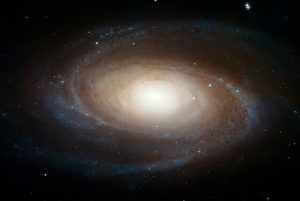A black hole is the remnant of a star of above three solar masses that has gone supernova and where there is no mechanism to stop it collapsing into a tiny, incredibly heavy core. There is so much mass that even light cannot escape. And because it sends out no light we cannot see it. The only way we might be able to detect one is by omission. It is a bit like in a court case whereby saying nothing you are lying by omission.

A black hole is really a neutron star. It rotates like a neutron star. It is just all that more compressed.
Against the vast backdrop of the illuminated heavens astronomers occasionally detect a point which is obscuring the illumination, revealing itself as a black hole. But as most of them are only some 30 kilometres in diameter they are still difficult to find.
Neutron-neutron repulsion can only counteract the force of gravity if the core of the dead star weighs less than three times the mass of the sun. In an extremely heavy core, no force can stop the matter from being squeezed further into a smaller and smaller space.
Just before a really big star explodes in a supernova its centre core collapses into a ball of neutrons. The explosion dissipates gases and materials into the void at speeds of up to 150 000 kilometres per second. All that is left is an invisible black core. Any material drawn toward it by the extreme gravitational forces will disappear when it crosses the so-called “event horizon”.
Though black holes do not give out light themselves we can sometimes detect their presence by external effects of their gravitational forces. For example, if a star or gas passes too close to a black hole it will be sucked across its event horizon. As this happens huge amounts of light and energy are given off into space.
In the case of a neutron star, incidentally, materials drawn towards it do not disappear. Instead, when material strikes the solid surface of a neutron star light is emitted and causes the star to glow.
Another opportunity to witness a black hole is when there is no room for all the gases being sucked in over the event horizon, and they are instead ejected in a massive twin burst. Each jet is 20 times wider than our solar system. This ignites a black hole wind—a so-called quasar (described in the section on galaxies), which creates a new galaxy. When it runs out of fuel as the galaxy matures the quasar dies down and the active galactic centre becomes a super black hole. Telescopes look for x-rays that are created by quasars as a signpost for a new galaxy.
The dark heart of the galaxy
Close to the centre of most galaxies lies a swarm of very dense stars. These stars are moving at millions of kilometres an hour. And at the centre will be a black hole, probably four million times or more the mass of our Sun. For example, there is a black hole at the centre of the Andromeda galaxy that is 140 million times the mass of our Sun. There are others 20 billion times that size.
Cygnus X-1
In 1964 Cygnus-X1 was the first black hole to be discovered. It lies some 6 070 light years distant in the Constellation Cygnus.
Cygnus X-1 is an example of a so-called stellar-mass black hole, a class of black holes that comes from the collapse of a massive star. The black hole pulls material in from a massive, blue companion star toward it. This material forms a disk that rotates around the black hole before falling into it or being redirected away in the form of powerful jets.
This black hole is spinning at maximum velocity, at more than 800 times a second, and is 14.8 times the mass of the sun. It was likely to have been almost this massive at birth, because of the lack of time for it to grow appreciably.
Gamma ray burst
A gamma ray burst (GRB) is a sudden burst of gamma radiation. It is the most powerful explosive event in the universe and may be triggered by collisions between a neutron star or a black hole, or by an extreme version of a supernova, called a hypernova. Count the number of gamma ray bursts and you can tell how many black holes are being created – at least one a day somewhere in the universe. There are indeed billions of them out there.
In the hypernova event a star a hundred times the size of the sun bursts violently and collapses into a black hole. In milliseconds the star is consumed so fast the black hole “chokes” and spews out two massive jets of gas from both polar regions. The outburst has the energy of a million trillion suns. Indeed, a GBR discharges hundreds of times more energy than the sun will produce in its entire lifetime. The two jets of energy—the GBR—hurtle through the universe at the speed of light. A gamma ray burst is only possible with massive gravitational forces.
For every 300 gamma ray bursts only one is pointed towards Earth. One at a distance of 1 000 light years from Earth would appear 500 times brighter than the sun. It would deplete our ozone, cause acid rain, flash burns and incineration. The far side of Earth might be OK but no one yet understands the after effects on the planet as a whole.
Back to Top
By Nigel Benetton, science fiction author of Red Moon Burning and The Wild Sands of Rotar.
Last updated:Saturday, 20 March 2021